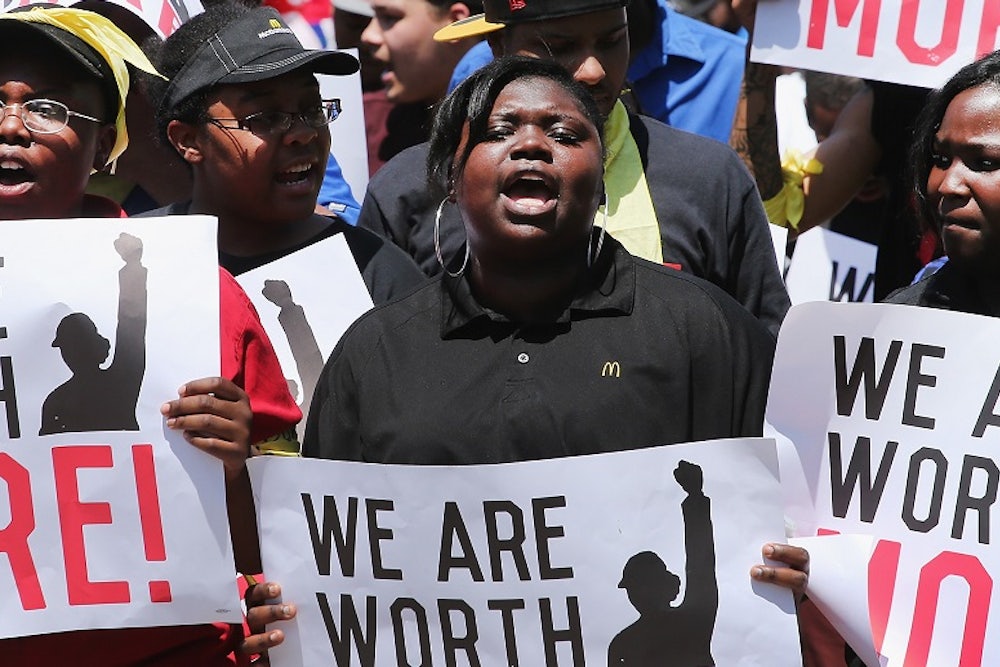While Republicans are blocking legislation to increase the national minimum wage, state legislatures are taking matters into their own hands. Between 2011 and June 30 of this year, more than a dozen states increased their minimum wages. This has offered economists an opportunity to examine whether those minimum wage hikes have reduced employment. The results are promising.
A month ago, I reported on a new study of 14 states that increased their minimum wages in 2014, either through legislation or an automatic adjustment for inflation. In those 14 states, employment growth was faster and the unemployment rate declined further than in states where the minimum wage was unchanged. As I noted then, it was important not to read too much into the study. It uses a small sample size over a limited time period and does not control for other factors that could be influencing employment growth in various states.
Saul D. Hoffman and Wai-Kit Shum, two economists at the University of Delaware, have now offered a more comprehensive look at the employment effects of state-level minimum wage increases. The authors examined employment effects of the 13 states that increased their minimum wages since 2011.1 But they didn’t just look at job growth for all workers during that period. Instead, they focused on two specific groups: teenagers not in college and adults without a high-school diploma—groups most likely to see negative job growth from a minimum wage hike.
Hoffman and Shum found that employment growth among teens not in college and adults without a high school diploma was stronger in states that increased their minimum wages than those that didn’t. But as with the analysis I reported on in September, this doesn’t tell us that much. Some outside factor could have increased job growth in those 13 states.
The researchers got creative and compared employment growth among teens not in college with males aged 30-49 with at least some college education. These comparisons are all done within states, so that economic conditions are affecting each group in similar ways. In other words, this helps control for many outside factors that could be affecting the data. In states that increased their minimum wages, employment for the teen sample grew by 2.32 percentage points compared with 1.1 percentage points for the adult sample. In other words, job growth was 1.22 percentage points stronger for these less-skilled workers. Although these results aren’t statistically significant, they also mean the researchers did not find a negative effect on employment growth, as conservatives often predict. (They repeated the same analysis with the sample of adults without a high-school diploma and found similar results.)
That’s called a “difference-in-difference” test, because it compares the change in a variable (in this case, job growth) between two different groups. Hoffman and Shum than take this one step further and compare those results with states that didn’t increase their minimum wages—a “difference-in-difference-in-difference” test. The results were similar.
“We see no evidence in the states where the minimum wage went up that the employment for those groups are affected negatively at all,” Hoffman said.
It’s important not to overstate the significance of this study. It is also only over a short time period (3.5 years at most) and all of these minimum wage increases were moderate, with a median change of $0.68, or 9.3 percent. Democrats are trying to raise the national minimum wage from $7.25 to $10.10, an increase of nearly 40 percent. The effects on employment could be more noticeable if that were to happen.
“The $10.10 is at the upper end of what is consistent with these results. It’s not $12 and it’s not $15,” Hoffman said. “Those are way beyond what I’m looking at, but that’s kind of in the range of what I’m looking at.”
But at the same time, these results shouldn’t be ignored either. Congressional gridlock has created a natural experiment for assessing the effects of the minimum wage, with more than a quarter of states raising minimum wages. It’s not the perfect conditions for this research, but it’s pretty good. So far, the results support the Democrats’ position.
There are fewer states in this study than in the previous one because minimum wage hikes in Delaware, California and D.C. took effect too recently.
